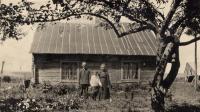
Ready for a Day of Skiing, New Sweden, 1931
New Sweden Historical Society
Text by Candace Kanes
Images from New Sweden Historical Society and Nylander Museum
The effects of the Homestead Act of 1862 are well known: more and more Americans and immigrants moved West to claim land the government made available at low cost to people who would live on the land.
Less well known, perhaps, is one notable effect of the act in Maine: the settlement of Swedes in Aroostook County.

Olof Anderson farm, New Sweden, ca. 1922
Nylander Museum
William Widgery Thomas, an 1860 graduate of Bowdoin College, was one of 30 consults President Abraham Lincoln appointed to promote immigration as part of the Homestead Act.
Thomas spent three years in Sweden, where he learned the language and culture, and decided that Swedes would make the perfect immigrants to T15, R3, a sparsely inhabited part of Aroostook County.

William W. Thomas, New Sweden, ca. 1900
New Sweden Historical Society
Officials in Maine and in Washington wanted the area inhabited not just for economic benefits, but to help secure the northern border with Canada, and, some observers have speculated, discourage French Canadians settlement.
The land, like that in the West, was divided into 160-acre lots. The plan was to have log houses built on the lots by the time the first group of Swedes arrived in July 1870.
Even though not all the houses were finished when Widgery and 51 Swedes arrived, the immigrants settled in and got to work, building roads, homes and clearing land. In 1871, more immigrants arrived and by the end of the year, 553 Swedish men, women and children were in residence in Aroostook County, some moving to existing homes close to the original colony.
Despite forest fires, challenging weather conditions for farming and other hardships, the colony grew and New Sweden became a town in 1895. Stockholm was incorporated in 1911.
By 1880, the Swedish immigrants had built a community center named the Kapitoleum (Capitol), four churches, seven schools, two starch factories, five shingle mills, 71 miles of roads and 305 houses with 362 barns.

